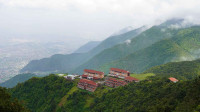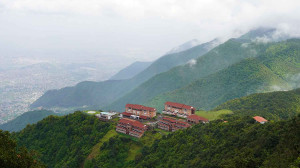Money
Farmers start transplanting paddy despite lack of chemical fertiliser
The Agriculture Ministry said there could be a shortage of around 20,000 tonnes of diammonium phosphate.
Sangam Prasain & Deo Narayan Sah
Farmer Dhurba Narayan Chaudhary of Biratnagar started transplanting paddy on his field on
Tuesday after the floodwaters caused by torrential rain began receding. The monsoon dropped record rains from Thursday to Saturday, triggering floods and inundating huge tracts of land across the country.
But for Chaudhary, the water swirling over his field was not a big concern. What he was most worried about was not being able to get adequate chemical fertiliser to apply on his paddy field.
“Transplantation has started, but this year we don’t have fertiliser. We are forced to plant the paddy saplings without fertiliser.” Since he has not been able to get chemical fertiliser, he has been using a locally produced organic nourishment named Heera which costs Rs2,000 per sack.
“We know the organic fertiliser will not support the growth of the plant, but we don’t have any other option,” said Chaudhary, who owns 5 bighas of land.
Another farmer Ram Dev Kamat has a similar tale of woe. He said he did not wait for chemical fertiliser to arrive at the government distribution centre, and went ahead with transplanting paddy without the soil fortifier. “It’s mid-July, and transplantation has been delayed already.”
Like Chaudhary and Kamat, thousands of farmers faced a shortage of chemical fertiliser this year. This may directly impact agricultural production and farmer incomes, and ultimately hit the country’s economy which is largely dependent on agriculture.
Agriculture Ministry officials said that there could be a shortage of around 20,000 tonnes of diammonium phosphate, the world's most widely used phosphorus fertiliser, during the paddy transplantation season.
On June 6, fearing a possible scarcity of chemical fertiliser, particularly diammonium
phosphate, the Cabinet gave an 'in principle' approval to the Ministry of Agriculture and Livestock Development to import 50,000 tonnes of fertiliser through a government-to-government deal with India. The deal would involve 30,000 tonnes of urea and 20,000 tonnes of diammonium phosphate.
The Cabinet had instructed the ministry to bring the fertiliser within the current fiscal
year which ends Tuesday.
An Indian inter-ministerial committee approved the immediate supply of the fertiliser to Nepal 'to meet the supply shortages in Nepal for the upcoming paddy season', according to Indian media. The Indian government assigned two state-run trading companies—Metals and Minerals Trading Corporation of India and State Trading Corporation Limited—to export the fertiliser to Nepal.
“We asked the companies to ship the fertiliser within July 15 from their stock, but they informed us that they were running short and had to import a fresh batch which would take two to three months,” said Bishnu Prasad Pokhrel, acting manager of the procurement and distribution department of Krishi Samagri Company.
“As delivery would be delayed and the price was high, the Nepali side did not continue negotiations.”
Pokhrel said that there would be no shortage of urea, but that they had run out of diammonium phosphate. “Some consignments will be arriving by mid-August,” he added. But that will be too late for the farmers.
Tej Bahadur Subedi, spokesperson for the ministry, said that the shortage of diammonium
phosphate would not be resolved immediately because the tender process would take time.
He said that farmers could apply ammonium phosphate sulphate and single superphosphate as an alternative which are easily available in the market. Salt Trading Corporation also sells single superphosphate, but it is not subsidised. Private traders have been importing and selling ammonium phosphate sulphate in the market.
“These two fertilisers have phosphate content and essential micro nutrients that can be used as an alternative to diammonium phosphate,” said Subedi.
The chemical fertiliser shortage is likely to drag down paddy output for the upcoming fiscal year at a time when the monsoon has also been projected to be subpar in the key paddy producing regions. Due to favourable rains and ample supply of chemical fertiliser, the country recorded a bumper harvest this fiscal year.
Nepal’s paddy harvest hit a record high of 5.61 million tonnes last season, up 9 percent, according to the ministry. This was on the back of a good monsoon and sufficient supply of chemical fertiliser.
The paddy cultivation season lasts for four months from May to August. The harvest continues until October.
A fertiliser shortage appeared this year because the Finance Ministry delayed releasing Rs3 billion to the Agriculture Ministry to import additional fertiliser to make up for reduced purchases due to a stronger US dollar and a price hike in the global market, said an official at Krishi Samagri Company, the state-owned company that imports agricultural goods and materials.
The government spends Rs10 billion on importing and Rs6 billion on subsidising chemical fertiliser annually.
The Agriculture Ministry had planned to purchase 286,000 tonnes of chemical fertiliser this fiscal year, but due to the appreciation of the dollar and a price rise in the global market, it was able to buy only 225,000 tonnes. The five-month paddy production cycle alone requires 150,000 tonnes of chemical fertiliser.
***
What do you think?
Dear reader, we’d like to hear from you. We regularly publish letters to the editor on contemporary issues or direct responses to something the Post has recently published. Please send your letters to [email protected] with "Letter to the Editor" in the subject line. Please include your name, location, and a contact address so one of our editors can reach out to you.




 6.84°C Kathmandu
6.84°C Kathmandu
-(1).jpg)















